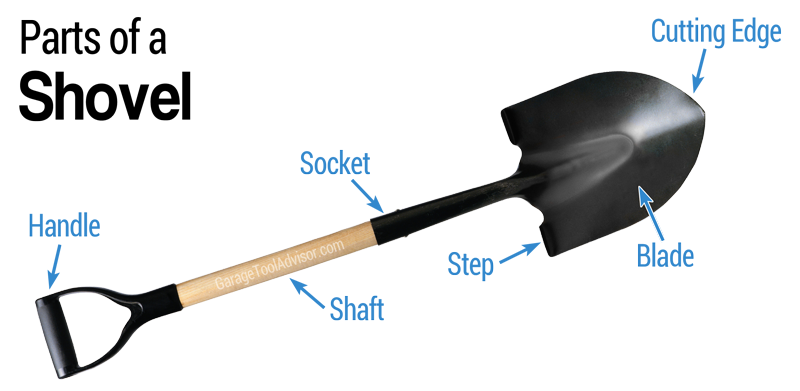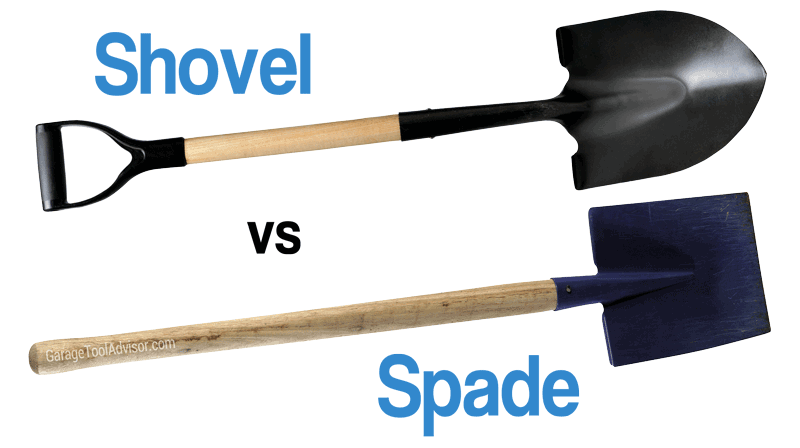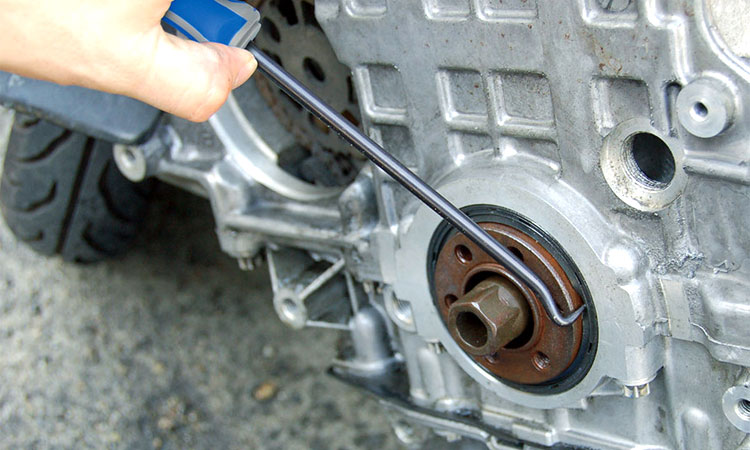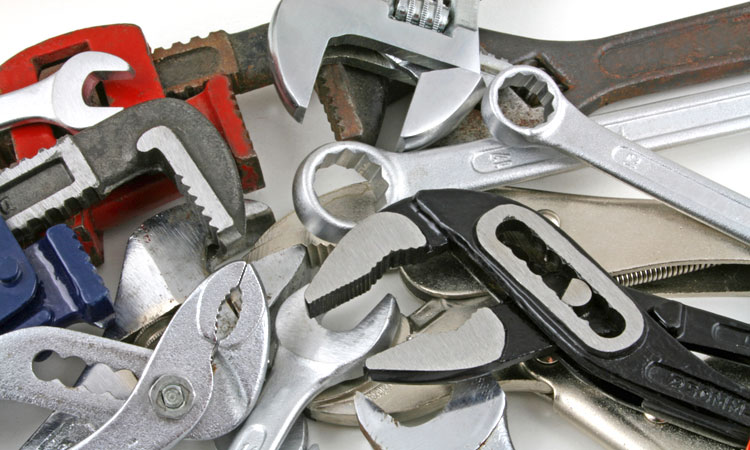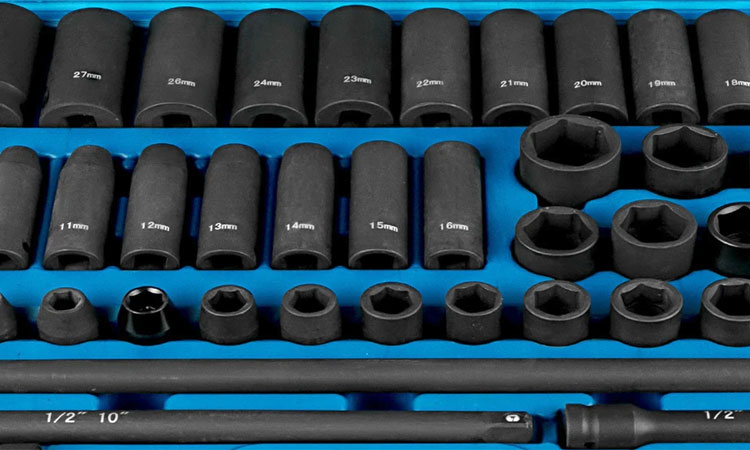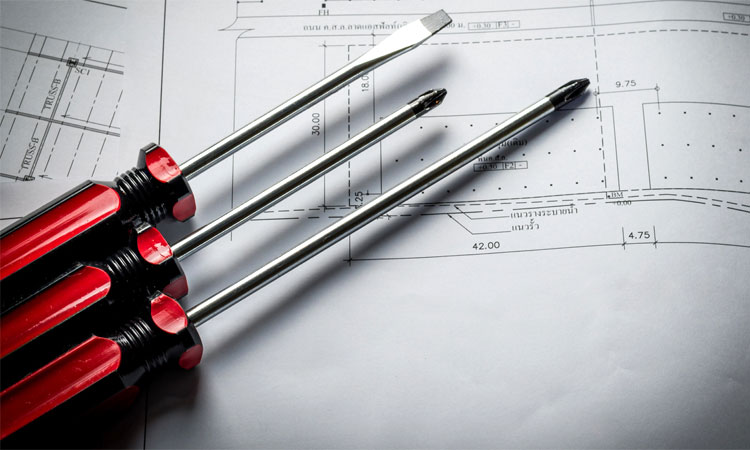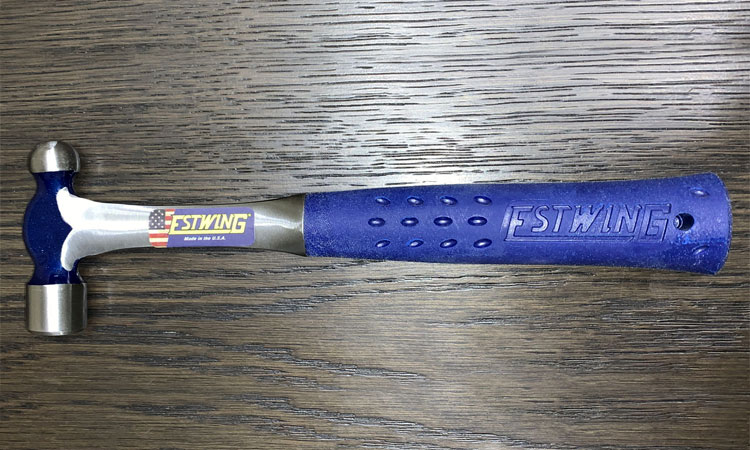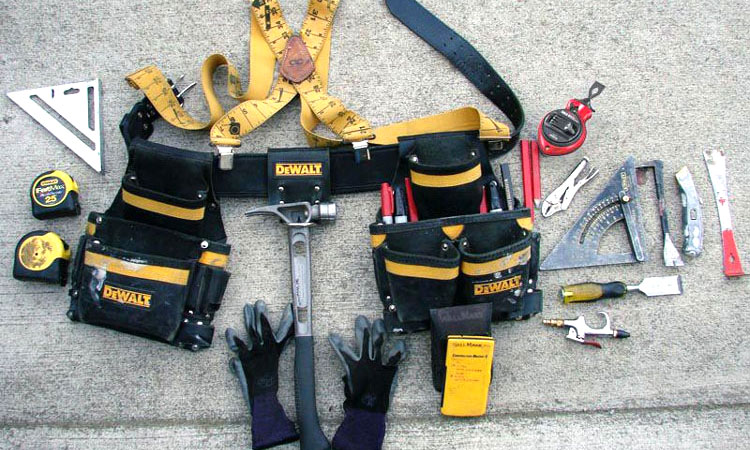36 Different Types of Shovels (and Their Uses)
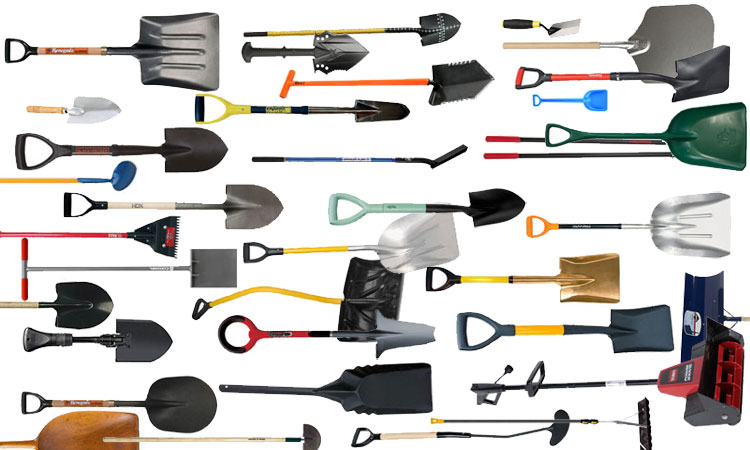
When you think of a shovel, you likely picture a square or pointed surface attached to a handle, and give no further thought. However, such a simple concept actually has quite a few variations and is not only one of the most versatile tools out there, but one of the most specialized at the same time.
Technically, even the spoon you eat your soup with is a type of shovel! Food aside, here are 36 different kinds of shovel to give you a feel for just how diverse this tool’s uses and designs really are.
See Also: 12 Different Types of Sanders
Types of Shovel
 Clam Shovel
Clam Shovel
As the name suggests, a clam shovel is perfect for digging up razor clams on the beach. The angle of the blade allows you to quickly dig up clams, even better than a clam gun. The blade angle can vary and a semi- (or full) stainless steel variation is preferred by many.
Instead of using it as a typical digging shovel, you push the shovel blade vertically into the sand using your body weight. Then you lift up the shovel while pushing forward to expose the clam in the sand.
 Coal Shovel
Coal Shovel
These short-handled shovels have a sturdy, square-tipped blade and are designed for moving coal and other gravel-like materials.
The back of the blade may be square or slightly curved, and the sides and back all curve up to form containing walls to hold more material. The flat bottom of the blade may also be used for smoothing gravel surfaces.
 D-Handle Shovel
D-Handle Shovel
This actually describes a grip variant more than a particular type of shovel. Shovels with a D-handle tend to have a shorter handle length with the end terminating in a D-shaped metal or plastic grip.
This grip improves control, maneuverability, and stability. As a result, many garden-oriented shovels and heavy-duty shovels such as coal shovels will tend to be D-handled models.
 Digging Shovel
Digging Shovel
The term “digging shovel” refers to a shovel that has a sharp cutting edge designed to pierce tougher ground.
The collars on digging shovels tend to be reinforced and most will also have a non-slip or non-standard handle (such as a D-grip or T-grip).
 Edging Shovel
Edging Shovel
Edging shovels have a smooth, flat blade with flat edges. It’s generally made thinner material than a spade and may include depth markings along the blade.
These tools provide a clean, precise cut along the borders of gardens and lawns.
 Ergonomic Shovel
Ergonomic Shovel
Also known as: bent handle shovel
Ergonomic shovels have a bent shaft to reduce strain on the back. They usually include a D-handle and are most often seen on snow shovels.
While these shovels are better for those who suffer from back problems, they have very poor lifting power, requiring more effort to lift debris over a high bank.
Instead, the shovel is best used for plowing across a surface, rather than wholesale removal.
 Fireplace Shovel
Fireplace Shovel
Part of a fire iron set, this is a flat spade with steep sides and back, making it resemble a long-handled scoop. As the name implies, it’s used to remove coals or debris from the fireplace.
 Flat Shovel
Flat Shovel
Also known as: flat nose shovel, spade
A flat shovel, or spade, is a shovel that has a flat cutting edge. These are less efficient at digging but provide superior scooping and moving power. They are also better at cutting straight edges in sod or other surface materials.
 Folding Shovel
Folding Shovel
Also known as: camping shovel, portable shovel
As the name implies, a folding shovel is designed to fold where the blade meets the shaft (sometimes also at a second point along the shaft) and lock into an open, closed, or (sometimes) 90 degree position.
These small shovels either have a standard or triangular grip and are perfect for camping or emergency use. Some variants also come with a pick tool.
Note that they sometimes have the nickname “trenching shovel” due to their military use in digging trenches, but should not be confused with the actual trenching shovel.
 Garden Shovel
Garden Shovel
Also known as: garden spade, garden trowel, hand shovel, hand trowel
A garden shovel is a small, short-handled gardening tool often erroneously called a garden spade. They have a pointed cutting edge and tend to have a V-shaped or rounded blade to improve scooping.
 Grain Shovel
Grain Shovel
Also known as: barn shovel, grain scoop shovel
This is a type of scoop shovel designed specifically for moving grain and other tiny granular materials.
 Gravel Shovel
Gravel Shovel
Also known as: rock shovel
Gravel Shovels usually have a spade edge, although some have rounded tips. The blade is either scoop or spoon-shaped to help with the lifting and transportation of various types of gravel or small stone materials.
 Half Moon Shovel
Half Moon Shovel
Shovels with a semi-circular blade are known as half-moon shovels. These tools are most often used for edging work.
The sharp blade allows for easy cutting and shaping of grass or sod by simply rocking the blade back and forth.
 Military Shovel
Military Shovel
Also known as: survival shovel, tactical shovel
Alton Brown used to always say a product designed to perform only one function was worthless. This type of shovel is known as the Swiss army knife of the shoveling world.
They vary greatly in the details, but the blades are usually designed to dig, cut, chop, and/or saw. Some come with shaft extensions and many have the ability to fold for easy transport.
 Measuring Shovel
Measuring Shovel
Invented by Maddox Prichard, the Measuring Shovel is not yet in production (as of early 2022), yet has already won several awards, and was co-funded by two members of Shark Tank in November 2019.
The blade and shaft of this tool include precise length and depth measurements to allow for accurate sizing and spacing of holes when planting trees and shrubs.
The tool is planned to be licensed out to a major tool company, possibly Stanley or Black+Decker and may be available later this year once a licensing deal is cemented.
Related: 5 Parts of a Tape Measure
 Metal Detecting Shovel
Metal Detecting Shovel
The hobby of metal detecting often leads to minor finds, but can also result in finding buried treasures such as ancient coins. The shovels used for this task vary in details but tend to have a few overall requirements.
First, they have pointed cutting edges. Second, one or both sides will have a serrated edge which helps in cutting roots. Third, the blade will generally be V-shaped with no curvature to allow for very precise digging.
 Mini Shovel
Mini Shovel
As the name implies, a mini shovel is a smaller, more portable version of a full-sized shovel. They may have the ability to fold, such as camping shovels, or have a solid design.
 Mulch Shovel
Mulch Shovel
A mulch shovel is a type of scoop similar to a grain shovel. However, the blade curves up towards the collar instead of having an angled rear wall.
This lightweight shovel makes getting scoopfuls of mulch out of a wheelbarrow and spreading large clumps on the ground easy.
 Non-Sparking Shovel
Non-Sparking Shovel
As the name implies, these are a special type of shovel designed to remove contaminated or volatile debris without creating a spark.
Made of heavy duty plastic or aluminum bronze, these are essential tools for firefighters and other rescue workers who may need to excavate trapped victims in an area where flammable liquid or gas is present.
 Pizza Shovel
Pizza Shovel
Also known as: pizza peel
Traditionally made of wood, a pizza shovel is a flat square board and handle used to slide pizza in and out of a brick oven.
Some modern versions use a metal blade, but this is one of the niches where a wooden shovel is preferred.
 Post Hole Shovel
Post Hole Shovel
Also known as: post hole digger
A form of double shovel, the blades are rectangular with often rounded corners and a semi-cylindrical design. They’re designed specifically to create rounded holes in which to insert poles and posts.
 Power Shovel
Power Shovel
Also known as: electric snow shovel, excavator
There are actually two different variations. The first is what is essentially a powered snow shovel. Available in gas and electric models, a power shovel works similar to their much larger snow blower counterparts. By turning a horizontal auger, it sucks up snow in its path and discharges it out of the way.
A power shovel is also a piece of excavating equipment comprising of treads, a cabin and engine assembly, boom, lever arm, and shovel bucket. These are most commonly used in large-scale removal of material and generally shifts the debris to a dump truck or debris pile.
 Roof Snow Shovel
Roof Snow Shovel
Also known as: roof rake, roof snow rake
These wide curved-blade shovels function quite differently from normal snow shovels. The handle is attached to the top of the blade, allowing the user to pull snow along the roof’s surface.
 Roofing Shovel
Roofing Shovel
Also known as: shingle shovel
These are generally square-bladed tools with a toothed cutting edge. This edge allows them to be slid under old shingles and dislodge the nails, as opposed to other shingle removing tools which leave the nails behind.
 Scoop Shovel
Scoop Shovel
Just as the name implies, the scoop shovel is a scoop with a long shaft and handle. The blade has a flat edge and tall sides with a curved back wall. It’s primarily used for the lifting and transportation of materials.
 Serrated Shovel
Serrated Shovel
Also known as: Root Assassin, root cutting shovel, Root Slayer
Perfect for cutting away at roots, the serrated edge of the blade is usually along the cutting edge but may also have it along one side.
Popular brands, such as the Root Slayer, have extra-sharp edges and are further designed to be efficient at cutting roots.
 Snow Shovel
Snow Shovel
One of the most common forms of spade on the market, snow shovels have a wide blade which is curved vertically and often includes ridges or grooves to aid in shifting large amounts of snow. A variation used for roofs is called a roof rake.
They come in a wider range of materials than most types of shovel, from plastic blades and wooden shafts to all-aluminum construction. Snow shovels have some ability to lift but tend to work best as a form of plow.
 Sod Shovel
Sod Shovel
Also known as: sod lifter
This is a type of half-moon shovel with an angled collar to allow the user to get under a section of sod and lift it away from the underlying soil.
The blade often curves further back along the edges, giving it more of a crescent moon appearance.
 Spoon Shovel
Spoon Shovel
A spoon shovel is often 8, 10, or 12 feet long and is used to clear mud, water, and backfill from sewers and manholes. They’re ideal for removing debris in deep, narrow holes and tight spaces.
 Square Shovel
Square Shovel
Also known as: square-point shovel, transfer shovel
These are a form of spade with steep walls and back on the blade. They’re poorly designed for digging but are perfect for scooping and transporting loose materials.
 T-Handle Shovel
T-Handle Shovel
This form of handle employs a cross beam at the end of the shaft. This allows for both hands to push down on the shovel while applying pressure to the step, making the overall diffing power of these shovels greater than most other models. They’re not as efficient at lifting as a D-handle and are usually paired with rounded tips.
 Tile Shovel
Tile Shovel
Also known as: trowel
An entire sub-class of trowel, the tile shovel has a flat, square blade with the handle attached to the back. The blade is designed to scoop, spread, and smooth mortar or plaster. Depending on the specific model, they may be used for tile, brick, or a variety of other masonry jobs.
Note that trowels also include a second sub-class which have pointed, bowled blades and more closely resemble miniature shovels.
 Toy Shovel
Toy Shovel
Also known as: plastic shovel
These little spades and shovels are made of plastic and designed to be used by children in sandboxes or at the beach. They often come in sets with plastic pails.
 Tree Planting Shovel
Tree Planting Shovel
Also known as: drain spade, tile spade, transplanting spade, sharp-shooter
These types of shovels are known by different names and have a more narrow blade to help size the hole. By cutting down on four sides, the shovel can easily break up and scoop out the debris.
These shovels perform the same job that would normally require a few different shovels to efficiently complete and are similar enough to trenching shovels that they may be used in a similar fashion when planting rows of shrubs instead of creating individual holes for each plant.
 Trenching Shovel
Trenching Shovel
Also known as: ditch shovel, trenching spade
Designed specifically for digging trenches, these shovels feature a narrow rectangular blade with a pointed cutting edge. The length of the shaft varies and the blade is set at an angle to allow for maximum efficiency.
Trenching shovels are used in a wide range of projects such as irrigation ditches and laying pipe.
 Wooden Shovel
Wooden Shovel
One of the more seemingly obsolete types of shovel, wooden shovels still have use in various fields such as barley malting where a metal blade may damage surfaces.
These tools are often made from a single piece of wood and can be quite sturdy when properly cared for.
Parts of a Shovel
Despite their simplistic appearance, shovels have had centuries of development and can be quite the complicated topic. Here are some popular sticking points regarding shovel design to help you become a shovel pro.
You may have thought a shovel only has two parts, but there are actually six major parts that make up a shovel. Knowing these parts and what they do makes it easier to find a shovel that’s right for your needs.
Blade
This is the big part at the end of a shovel that’s used for digging. The shape may be squared, curved, or pointed. It may also have a curved or flat surface.
Cutting Edge/Tip
The cutting edge is the part of the blade which strikes the ground. Pointed tips are perfect for breaking hardened surfaces while square-tipped edges are best for scooping up loose materials. The cutting edge may be sharp or dull, depending upon the shovel’s function.
Handle (AKA Grip)
There are four major types of grip, D-handle, standard, T-handle, and triangular. Each grip has its own benefits and affects how well a shovel functions in a specific task.
Shaft
The haft is the non-grip portion of a handle. This may be long or short, depending on the type of shovel. Long-handled shovels often round the shaft instead of adding a shaped handle. This is known as a standard handle.
Socket (AKA Collar)
The socket is the junction of the blade and shaft. In some cases, it’s a single piece connected to the blade and the shaft is inserted. In other cases, it may be a separate piece that connects the shaft and blade, sometimes with a hollow portion intentionally left at the end of the shaft.
Step
The back of the blade will often (but not always) have a flattened surface. This step allows the user to place their shoe on the back to add their body weight to the pressure being exerted on especially tough surfaces.
See Also: 8 Parts of a Hammer
Shovel vs Spade
As crazy as it sounds, people frequently get spades and shovels backwards. The key difference is the cutting edge, but spades actually are the ones with the flat tip, not the pointed or curved tip as one would expect.
Spades are primarily used for gardening tasks, such cutting edges and borders or loosening topsoil. They may or may not have a D-handle.
Meanwhile, the shovel is designed to create holes in the ground. The curved or pointed tips allow a shovel to get deeper into solid ground. The blade tends to be more bowl-shaped or recess deeper near the socket, making them better at hauling materials.
Of course, the two terms are generally used interchangeably, so the next time you play cards, calling out the “Ace of Shovels” isn’t necessary.
Shovel Materials
Just as shovels vary greatly in design, the materials used may also vary to a large degree. The blade is most commonly made of steel, aluminum, or a hard plastic. Primitive technology shovels use a scapula (shoulder bone) of an animal or stone.
A shovel’s shaft is more commonly made of ash, maple, oak, fiberglass, or aluminum (usually hollow). Wooden shovels will use a single piece of wood for both the shaft and blade. Handles may be wood, aluminum, or a combination of wood, metal, and/or plastic.
Think about the function of your shovel when choosing the materials, especially the blade and collar assembly. Heavy duty shovels are best made of steel with a wood metal shaft.
Delicate or food materials are better served by an all-wooden design. Meanwhile, snow shovels work best from a lightweight design provided by an aluminum or plastic blade and aluminum or fiberglass shaft.

 Clam Shovel
Clam Shovel Coal Shovel
Coal Shovel D-Handle Shovel
D-Handle Shovel Digging Shovel
Digging Shovel Edging Shovel
Edging Shovel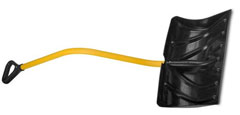 Ergonomic Shovel
Ergonomic Shovel Fireplace Shovel
Fireplace Shovel Flat Shovel
Flat Shovel Folding Shovel
Folding Shovel Garden Shovel
Garden Shovel Grain Shovel
Grain Shovel Gravel Shovel
Gravel Shovel Military Shovel
Military Shovel Metal Detecting Shovel
Metal Detecting Shovel Mini Shovel
Mini Shovel Mulch Shovel
Mulch Shovel Non-Sparking Shovel
Non-Sparking Shovel Pizza Shovel
Pizza Shovel Power Shovel
Power Shovel Roof Snow Shovel
Roof Snow Shovel Roofing Shovel
Roofing Shovel Scoop Shovel
Scoop Shovel Serrated Shovel
Serrated Shovel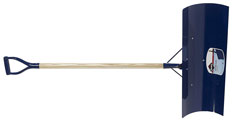 Snow Shovel
Snow Shovel Square Shovel
Square Shovel T-Handle Shovel
T-Handle Shovel Tile Shovel
Tile Shovel Toy Shovel
Toy Shovel Wooden Shovel
Wooden Shovel